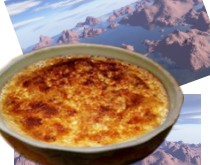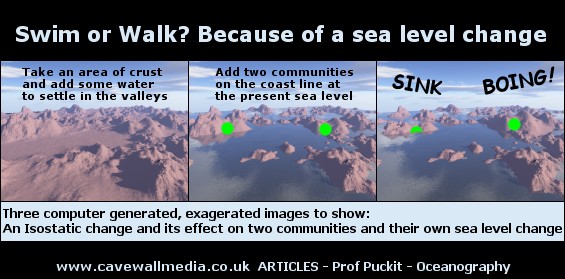 The planet Earth on which we stand, has a thin surface skin (lithosphere), which floats on top of a much thicker, semi-fluid, hot layer (asthenosphere).
The planet Earth on which we stand, has a thin surface skin (lithosphere), which floats on top of a much thicker, semi-fluid, hot layer (asthenosphere).
A homemade rice pudding with a skin comes in useful to visualise this and can be used to demonstrate a much larger, real Earth occurrence...
.
This real Earth occurrence is known as Isostatic Change, a vertical movement, both up and down, of the lithosphere. This can affect coastal communities by altering their sea levels.
The lithosphere on which we build is flexible. It lays in equilibrium upon the asthenosphere until a vertical force affects it… then the isostatic changes occur… continuing until a new equilibrium is attained.
Cue the pud….
Get the permission of the pudding owner… then poke the pud. With the use of a finger, push vertically down, a little bit, on the skin and at that point, it will sink down under the force, whilst somewhere else, the skin will lift up. Release your finger and the sunken point will slowly rebound, whilst the lifted area will sink back down.
Isostasy and isostatic change….
Isostasy is the cool word given to the skin of the pudding… the lithosphere… when it is laying balanced, in equilibrium, on top of the semi-fluid below it, with no new vertical forces acting on it.
Isostatic change is what the poked pudding demonstrated. An isostatic change occurred as the pudding was being poked downwards. The skin was forced vertically, adjusting (downwards) to compensate, whilst elsewhere it would rise in balance.
Sea level changes…. Back to the pud….
Pour a little milk into the valleys and let settle. Once all is settled (in its state of equilibrium), then use some imagination:
Imagine the pudding as a miniature Earth’s surface area, with islands surrounded by a sea. Imagine two communities on the ‘coastline’, then poke the pud again, near one of these communities.
The land, where poked, will sink below the surface…. to the occupants of that community, looking out:
* They would observe that their sea level was rising.
Elsewhere, if the second community was on a piece of land lifted up, then to the occupants of that community, looking out:
* They would observe that their sea level was dropping.
Real Earth occurrence….
No giant fingers have been spotted to date, but vertical forces such as massive tonnage of glaciers, force an isostatic change. The lithosphere below the glacier will sink, whilst elsewhere there will be an uplift.
In the times when these glaciers melt away, that area will rebound back upwards whilst elsewhere it will sink a little.

An example of isostatic change occurring in this present day time….
The glaciers over Scandinavia are melting away and this area is rebounding. As a consequence of this, the land around the southwest of the UK is sinking.
It occurs too slowly for us to feel the land moving… It occurs in measurements, too small to notice on a daily observation, but over longer time frames…. it does occur. It can be measured in mm/year.
This is one of many Earth processes. Note that the sea level changes here have to do with the land moving vertically and not the sea increasing or decreasing in volume (another process)…. more later.
.
“Prof Puckit…” is a CaveWallMedia project… Bringing information & musings… for intrigue, education, entertainment… Buy CaveWallMedia a coffee with an opportunity to place a comment if you would like.
.
